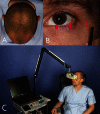Optic nerve monitoring
- PMID: 24436741
- PMCID: PMC3721018
- DOI: 10.1055/s-0033-1343783
Optic nerve monitoring
Abstract
Orbital and anterior skull base surgery is generally performed close to the prechiasmatic visual pathway, and clear strategies for detecting and handling visual pathway damage are essential. To overcome the common problem of a missed clinical examination because of an uncooperative or unresponsive patient, flash visual evoked potentials and electroretinograms should be used. These electrophysiologic examination techniques can provide evidence of intact, pathologic, or absent conductivity of the visual pathway when clinical assessment is not feasible. Visual evoked potentials and electroretinograms are thus essential diagnostic procedures not only for primary diagnosis but also for intraoperative evaluation. A decision for or against treatment of a visual pathway injury has to be made as fast as possible due to the enormous importance of the time elapsed with such injuries; this can be achieved additionally using multislice spiral computed tomography. The first-line conservative treatment of choice for such injuries is megadose methylprednisolone therapy. Surgery is used to decompress the orbital compartment by exposure of the intracanalicular part of the optic nerve in the case of optic canal compression. Modern craniomaxillofacial surgery requires detailed consideration of the diagnosis and treatment of traumatic visual pathway damage with the ultimate goal of preserving visual acuity.
Keywords: flash visual evoked potentials (VEPs); megadose methylprednisolone; optic nerve decompression; optic nerve trauma; visual pathway damage.
Figures







Similar articles
-
Diagnosis and treatment of optic nerve trauma.Facial Plast Surg. 2014 Oct;30(5):518-27. doi: 10.1055/s-0034-1393702. Epub 2014 Nov 14. Facial Plast Surg. 2014. PMID: 25397707 Review.
-
[Controversies and current status of therapy of optic nerve damage in craniofacial traumatology and surgery].Mund Kiefer Gesichtschir. 1999 Jul;3(4):176-94. doi: 10.1007/s100060050128. Mund Kiefer Gesichtschir. 1999. PMID: 10474263 Review. German.
-
The use of flash visual evoked potentials in the early diagnosis of suspected optic nerve lesions due to craniofacial trauma.J Craniomaxillofac Surg. 1996 Feb;24(1):1-11. doi: 10.1016/s1010-5182(96)80070-9. J Craniomaxillofac Surg. 1996. PMID: 8707935
-
[Flash-evoked visual potentials in the early diagnosis of optic nerve injury due to craniofacial fractures].EEG EMG Z Elektroenzephalogr Elektromyogr Verwandte Geb. 1991 Dec;22(4):224-9. EEG EMG Z Elektroenzephalogr Elektromyogr Verwandte Geb. 1991. PMID: 1786783 German.
-
Management of traumatic optic neuropathy.J Craniomaxillofac Trauma. 1996 Spring;2(1):14-26; discussion 27. J Craniomaxillofac Trauma. 1996. PMID: 11951471
Cited by
-
Monitoring of visual-evoked potentials during fat packing in endoscopic resection of a giant pituitary adenoma.Surg Neurol Int. 2024 Oct 25;15:387. doi: 10.25259/SNI_719_2024. eCollection 2024. Surg Neurol Int. 2024. PMID: 39524572 Free PMC article.
-
Totally Organic Hydrogel-Based Self-Closing Cuff Electrode for Vagus Nerve Stimulation.Adv Healthc Mater. 2022 Dec;11(23):e2201627. doi: 10.1002/adhm.202201627. Epub 2022 Oct 5. Adv Healthc Mater. 2022. PMID: 36148587 Free PMC article.
-
Guidelines for Orbital Defect Assessment and Patient-Specific Implant Design: Introducing OA2 (Orbital Assessment Algorithm).Craniomaxillofac Trauma Reconstr. 2024 Dec;17(4):NP298-NP318. doi: 10.1177/19433875241272436. Epub 2024 Oct 24. Craniomaxillofac Trauma Reconstr. 2024. PMID: 39544314 Free PMC article.
-
[Optic nerve decompression-state of the art].HNO. 2022 Oct;70(10):736-742. doi: 10.1007/s00106-022-01209-2. Epub 2022 Aug 18. HNO. 2022. PMID: 35980401 Review. German.
-
An insight into the vision impairment following traumatic brain injury.Neurochem Int. 2017 Dec;111:103-107. doi: 10.1016/j.neuint.2017.01.019. Epub 2017 Feb 2. Neurochem Int. 2017. PMID: 28163060 Free PMC article. Review.
References
-
- Lang J. [Posterior ethmoid cells and their relation to the optic canal] HNO. 1988;6:49–53. - PubMed
-
- Osguthorpe J D, Sofferman R A. Optic nerve decompression. Otolaryngol Clin North Am. 1988;6:155–169. - PubMed
-
- Wolin M J, Lavin P J. Spontaneous visual recovery from traumatic optic neuropathy after blunt head injury. Am J Ophthalmol. 1990;6:430–435. - PubMed
-
- Elisevich K V, Ford R M, Anderson D P, Stratford J G, Richardson P M. Visual abnormalities with multiple trauma. Surg Neurol. 1984;6:565–575. - PubMed
-
- Habal M B, Maniscalco J E, Rhoton A L Jr. Microsurgical anatomy of the optic canal: correlates to optic nerve exposure. J Surg Res. 1977;6:527–533. - PubMed
Publication types
LinkOut - more resources
Full Text Sources
Other Literature Sources
